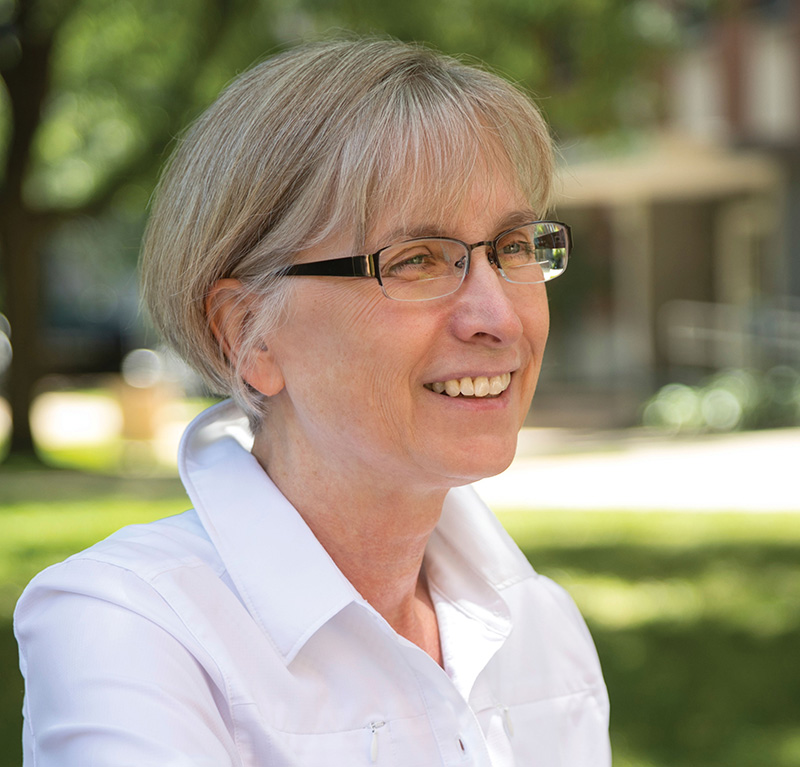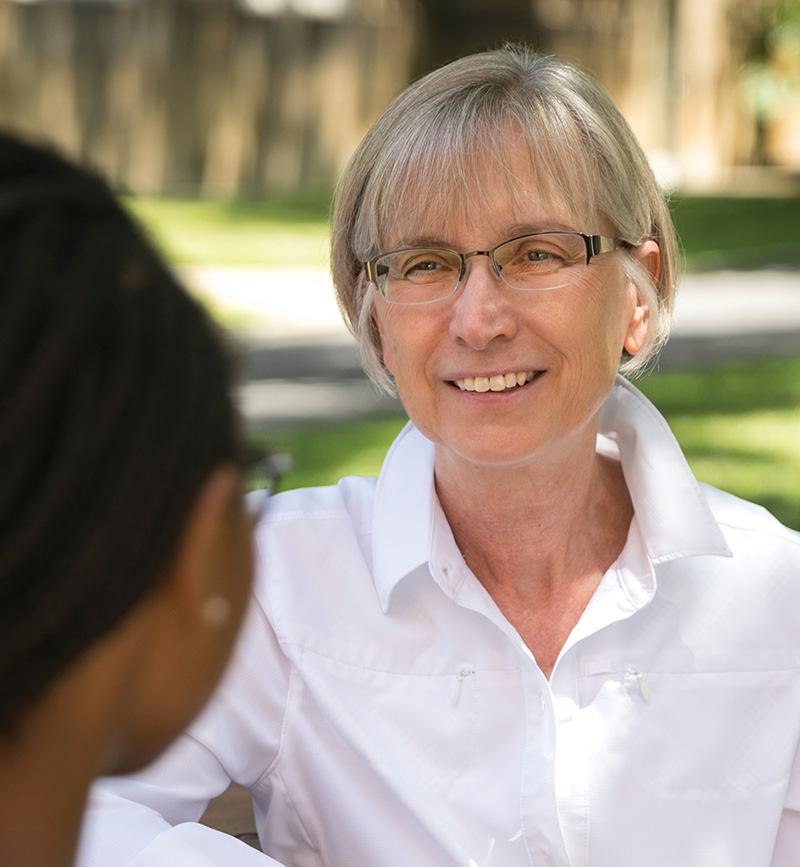Dr. Clare Rimnac ’80G ’83 Ph.D. has led a distinguished career in research and teaching, applying the principles of materials science in developing biomedical innovation. She is currently the Wilbert J. Austin Professor at the Case School of Engineering at Case Western Reserve University. Her work has focused on lifetime performance and degradation of orthopaedic medical devices and materials, including 13 years as a Research Fellow and scientist at the Hospital for Special Surgery in New York City prior to her Case Western Reserve appointment. Rimnac is the first woman to earn a Ph.D. in materials science from Lehigh, and to receive the Materials Science and Engineering Department’s Distinguished Alumni Award.
Q: Much of your career has been in research. How did you decide that this was what you wanted to do?
A: I was always interested in science, particularly biology. Then I went from graduate school in engineering to a research position at the Hospital for Special Surgery. And I really enjoyed it; I spent 13 years in research there. But what I missed was teaching and mentoring students. At Case Western Reserve I combine the two: teaching and research – my two great passions. So in the long run everything kind of merged together: engineering at both the fundamental and applied levels, and even my original interest in biology by working in areas of medicine.
 Q: What excites you about research?
Q: What excites you about research?
A: The pursuit of knowledge and discovery. For me there is nothing more exciting than the opportunity to ask questions and form hypotheses about elements of engineering or nature that you don’t understand and see if you can help answer those questions. And when you experience the thrill of discovery, it’s enormously satisfying.
Q: Your early career was focused on traditional materials science, on industrial applications of steel, PVC, and other materials. Yet, the impact of your work is better described as ‘health and biomedicine.’ How did you forge that ‘interdisciplinary’ path?
A: When I was an undergraduate at Carnegie Mellon, one of our faculty members was working on biomedical applications and I found it very interesting. On term papers I almost always wrote about a biomedical application. Then at Lehigh University, I worked on polymer fracture and participated in work for the Hospital for Special Surgery. When Dick Herztberg presented the work that he did for the hospital he took me along. I expressed interest and the people at the hospital offered me a postdoctoral fellowship in their biomechanics group. Then they asked me to stay on as a full-time researcher in the biomedical field. It was a good fit.
Q: What role does materials science play in emerging ‘engineering-centric’ fields like personal/mobile health, energy systems and environmental sustainability, and pervasive computing?
A: Materials science plays a role in everything made by engineers. In personal mobile health, advanced materials are needed for things like embedded sensors. In energy systems and environmental sustainability, we need to understand how to make solar panels better so that they don’t degrade as fast. We’re doing research in that area at Case Western Reserve. Environmental sustainability includes developing biodegradable materials that don’t pollute. Pervasive computing is another area where we are looking for alternative materials that are more efficient in recycling so we need fewer initial raw materials. At the core of these and many other areas is a deeper and bettering understanding of advanced materials.
Q: Over your career, you have collaborated with and been supported by government and private agencies. How important are externally focused collaborations for academic research?
A: Responsiveness of academia to the needs of the nation is extremely important. The funding agencies look to researchers to help guide them and tell them the emerging problems and needs, and vice versa also. There’s a constant conversation between academic institutions and the funding agencies. Researchers prioritize where they should direct their energy, then go to the funding agencies with proposals on how they would address an emerging problem.
 Q: Can you cite a few important or lasting contributions in medicine that you and your teams have made?
Q: Can you cite a few important or lasting contributions in medicine that you and your teams have made?
A: One contribution I feel good about is when we identified a problem with the plastic used in total joint replacements. The material was degrading in a way not previously appreciated. From our research and that of others in the field, the industries that made these devices were very responsive and they modified the production of the plastics so they are much more resistant to degradation and will last longer for patients today.
Another contribution is our research on how donor (allograft) bone tissue behaves following processing for implantation in another person. When you use bone from another person, it needs to be sterilized, so that it doesn’t cause infection. The sterilization process can alter the mechanical properties of the bone tissue. We’ve been learning a lot about what that sterilization process does to bone tissue, making discoveries that will hopefully help those sterilized allograft bone constructs last longer in future patients.
Q: Your engineering courses covered synthetic and natural materials, but not human tissue. Where did you learn that?
A: During my postdoctoral fellowship at the Hospital for Special Surgery, I had great mentors who helped me dig deeply into the biology and mechanics of the musculoskeletal system. That’s what a good researcher does. It’s life-long learning. You dig into the literature; sometimes you have to self-teach. You find people who know the field and you learn from them so that you can address those problems. For me that’s what makes research joyful. I’m constantly learning new things, often from my students.
Q: Where is the field of orthopedic biomechanics heading with respect to new devices and materials? What needs are now being addressed? What innovations are on the horizon?
A: In total joint replacements, the field is headed toward personalized devices. There is also a lot of interest in surface modifications to make the devices more durable and more resistant to infection. Innovations are likely coming in embedded sensors that will help to provide ongoing information and feedback from the patient.
Q: Faculty research advisors are especially proud of students find who success in postdoctoral academic careers. Knowing what you know now, what might you have done differently?
A: Knowing what I know now, I don’t think I would have done anything differently: I followed my passion. That’s the advice I give – follow your heart. I am thankful I accepted the postdoctoral fellowship – at that time not a common step. I had several offers from industry, but I saw the opportunity to make a contribution to do good for humanity and help people in need by making better joint replacement devices.
Q: What advice would you give to students today considering a career in academic research, particularly in engineering and health/biomedicine?
A: Engineering is an incredibly fertile field to make societal impact. Sometimes we don’t think of engineering as a field that can change the world, or make the world a better place. But there are many opportunities to apply your engineering talent to improve the quality of people’s lives. In health and biomed there are tremendous needs. Many can be addressed by engineers.
 Q: You’ve held a number of leadership positions and earned many accolades throughout your career. Which of these do you find most professionally and/or personally rewarding?
Q: You’ve held a number of leadership positions and earned many accolades throughout your career. Which of these do you find most professionally and/or personally rewarding?
A: I have served as deputy editor for one professional journal and am now serving as an associate editor for another. I find helping authors express their work in the best possible way to be very rewarding. I was very honored to serve as president of my primary research organization, The Orthopedic Research Society. In terms of accolades, recognition by the Materials Department at Lehigh University as a distinguished alumna was very thrilling. And, I am very honored to have recently been accorded the award of Distinguished University Professor at Case Western Reserve. One of the most rewarding aspects of my career has been simply being a professor. It has given me the opportunity to work with and mentor incredible young men and women. It is such a joy to work with them and see how their careers develop.
Q: Have any of your students gone on to medical or teaching careers?
A: Yes, several. One student, Michael Sobieraj, is an M.D./Ph.D. in practice as an orthopedic surgeon and is developing his academic career. Several of my undergraduate students have gone on to medical school. My first Ph.D. graduate, Ozan Akkus, is now a full professor here at Case Western Reserve in mechanical and aerospace engineering.
Q: Your final word?
A: For students wanting to pursue a career in research, funding is tighter today and the opportunities are not as abundant. But my advice is to persist and to believe in your dream. It really has been a tremendous joy to do research, to pursue my passion in medical research, and to educate the next generation of engineers and researchers. I’ve had the privilege to live the dream.
